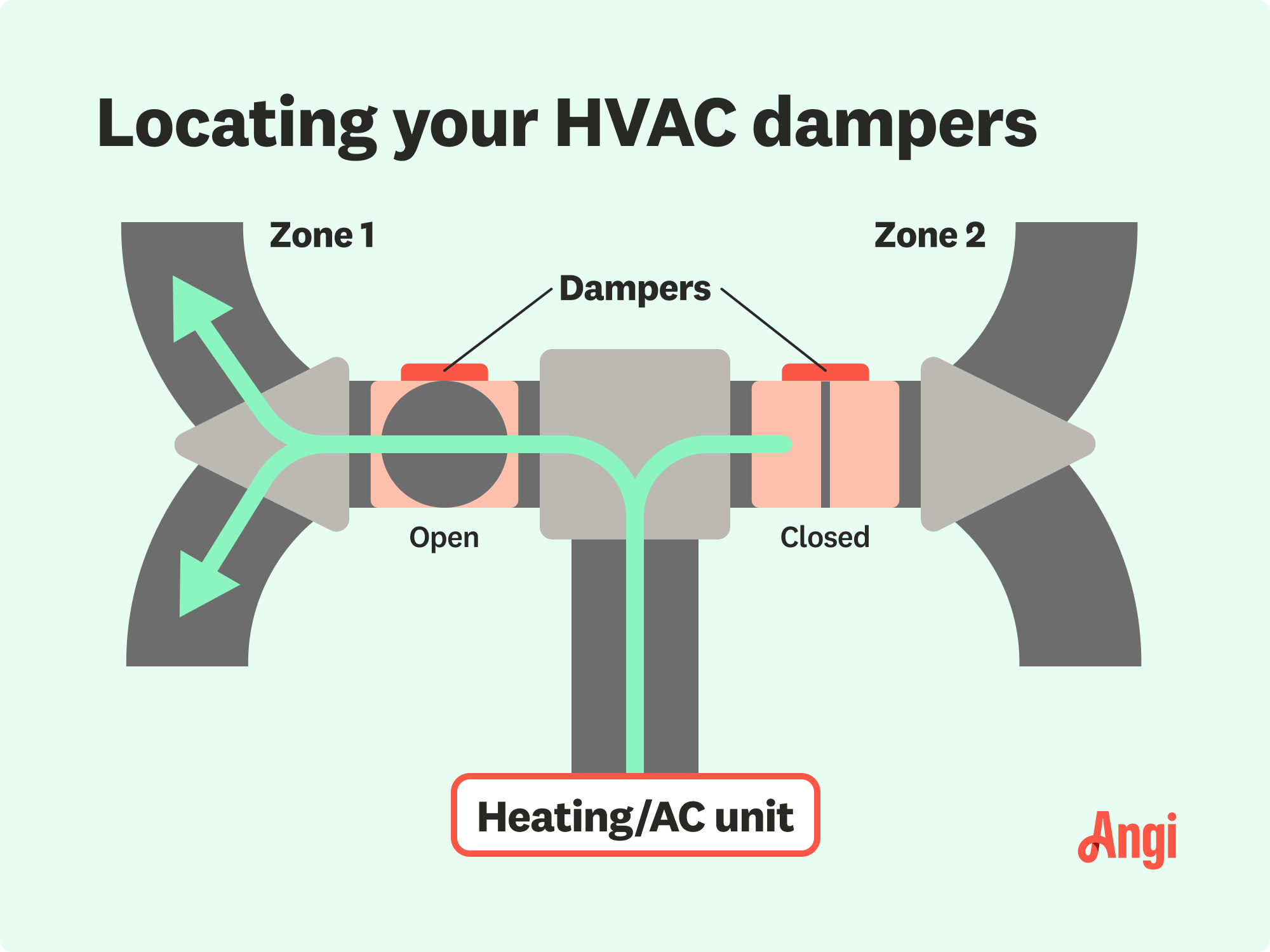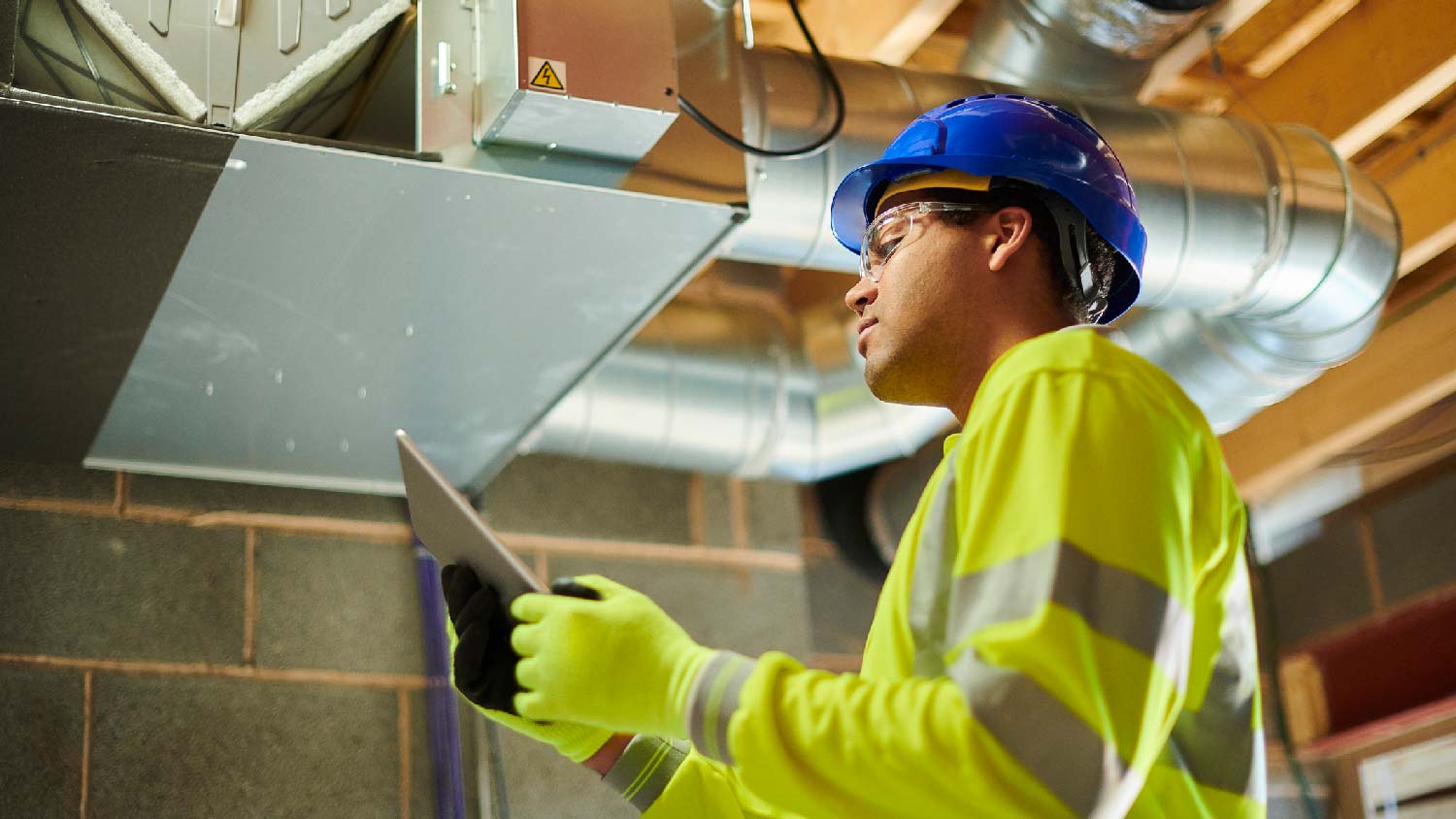
A blower door test can identify air leaks in your home and help boost energy efficiency. Use this blower door test cost guide to see what your test will total.
This simple HVAC part is the key to a more comfortable and well-ventilated home


Dampers are small but mighty components of your HVAC system, helping direct airflow and regulate the temperature inside your house. Depending on the season, you can open and close these valve-like devices to warm or cool your home—but to do that, you have to know where they are. Below, we’ll explain how to find dampers in ductwork so you can adjust them and keep your house comfortable all year.
First things first: What is a damper? HVAC dampers (or duct dampers) are valves inside your ductwork. Like a dam, you can open and close your dampers to control how much air comes through your HVAC system.
You’ll want to open and close your dampers throughout the year to direct airflow to the parts of your home that need heating or cooling. For example, in summer, it’s best to open upstairs dampers and close downstairs ones so cool air flows upwards. In winter, it’s the opposite.
Quality ductwork will increase the efficiency of your HVAC, sometimes by 20% to 30%. This is because there is reduced air leakage due to better insulation and more optimized airflow. This means your HVAC doesn't have to work as hard to keep the desired temperature, so it uses less energy.
There are two categories of dampers: manual and automatic. If you have manual dampers, you’ll need to adjust them by hand whenever you need to control airflow in your home. Automatic dampers have motors to open and close automatically, so you don’t need to do it yourself. Homes with HVAC zoning systems use automatic dampers.
There are multiple types of dampers in these categories:
Butterfly flat dish dampers: These easy-to-install dampers have butterfly-shaped hinges and circular blades that open and close to control airflow. They’re best suited for round ducts.
Louver dampers: Louver dampers have slats that automatically close depending on the pressure levels in your ductwork. They work well with all duct sizes.
Blade dampers: Blade dampers have two blades that move in the same or opposite direction to control airflow.
Inlet vane dampers: Rather than directing or controlling airflow, inlet vane dampers are like small vents and help adjust the air pressure in your ducts.
If you have manual dampers, it’s essential to know where they are since you’ll need to adjust them when the seasons change.
HVAC dampers are most often found in the main trunk line before and after major junctions. You can also find them at various points on multiple system ducts, with two dampers on every main line 90 degrees apart.
Next, find your HVAC system’s main trunk line, the large duct that comes from your furnace and distributes air into your home. Then, trace the main trunk line until you see a lever or handle attached to the duct. This is your damper.
Not every house has dampers, so don’t panic if you can’t find any. However, dampers are great for regulating airflow and temperature, so you might want to hire a pro to install some if you don't have them.


Your dampers play a pivotal role in keeping your house comfortable and well-ventilated, so it’s important to look after them—and the ducts that they’re in. Here are some tips for taking care of your dampers and ductwork.
Take note of any strange sounds in your ductwork. Older dampers often swing open and close, making booming or banging noises. If that’s happening at your house, bring it up with your HVAC specialist.
Stay on top of your HVAC inspections. Ideally, you should have a pro inspect your HVAC system—including your dampers—twice yearly. On average, each visit costs between $150 and $500.
Clean your ducts when necessary. If you notice excessive dirt and debris, mold and mildew, or vermin inside your ducts, it’s time to clean them. Air duct cleaning costs usually range from $270 to $490.
You shouldn’t have much trouble locating and adjusting your dampers, but if you do, don’t hesitate to call a local duct installer. They can show you where to find your dampers, teach you how to open and close them, and ensure they’re in good working condition. If you need to replace a broken damper or install a new one, they can handle that, too.
Adding dampers to existing ductwork costs anywhere from $1,700 to $2,000 for a standard two-zone setup. If you want to add more zones, it’ll cost $350 to $500 per zone, depending on the damper type and installation complexity. The dampers alone cost $70 to $340 per unit, though this depends on the available features and the quality of the materials. Labor is a primary cost factor here, as it takes a while to access the ductwork and install the necessary dampers.
Extremely nice and goes above and beyond to please customers.
Chis was a professional and a gentleman. When the men arrived they went straight to work and completed the job quickly. If I had any concerns Chris listened and made sure it was addressed. I would highly recommend their company.
The task at my location was difficult and took longer to accomplish due to the high-pitched slope of the roof. The staff was wonderful and hardworking, and the individuals were nice and considerate towards my property. We highly recommended by me as they are the best in this industry.
Gave quote quickly. Scheduled and completed work in a timely manner. Fence and gates look good.
Friendly, honest,, reliable and thorough. Very satisfied with their customer and the job done.
Very professional. Very punctual and knowledgeable. Very detailed and clean as he go.
Professional and easy to work with. Showed up early and finished on schedule. I highly recommend them.
Mr. Owen was prompt, thorough and professional. He went above and beyond to assist us.
Matt was very professional and so helpful through the entire roof replacement process from inspection to completion. He went above and beyond in working with our insurance company and walking me through every step along the way. The office responded quickly and were able to get us scheduled...
Ask Jeff what's going on. Very easy to talk to and willing to explain the steps, trends, and best practices.
From average costs to expert advice, get all the answers you need to get your job done.

A blower door test can identify air leaks in your home and help boost energy efficiency. Use this blower door test cost guide to see what your test will total.

If your furnace is malfunctioning, it could be a faulty control board. Find out what a furnace control board replacement costs for parts, labor, and more.

Find out the average humidifier repair cost, what impacts pricing, and how to save. Get expert tips to budget for your humidifier repair.

There are a few different types of refrigerant for AC systems, but some contain environmental hazards. Learn about the five main types of refrigerant.

Your return air vent is responsible for removing warmer air, so testing it ensures you keep your environment comfortable and there are no HVAC problems.

Ductwork losing energy? Here are six duct sealing methods that will help you get some big savings on your monthly energy bills.